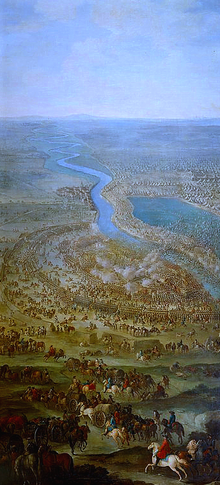Mustafa II
| Mustafa II | |
|---|---|
| Caliph of Islam Ottoman Sultan | |
 | |
| Reign | February 6, 1695 – December 8, 1703 |
| Predecessor | Ahmed II |
| Successor | Ahmed III |
| Sultan of the Ottoman Empire | |
| Consort | Ali-cenab Haseki Sahila Sabkati Sultan Shehsuvar Sultan Hüma Şah Haseki Afife Sultan Hanife Haseki Hafsa Sultan Hanife Hâtûn Fatma Şahin Hâtûn |
| Royal house | House of Osman |
| Father | Mehmed IV |
| Mother | Emetullah Rabia Gülnûş Sultan |
| Tughra |  |
Mustafa II (Ottoman Turkish: مصطفى ثانى Muṣṭafā-yi sānī) (February 6, 1664 – December 28/30, 1703) was the Sultan of the Ottoman Empire from 1695 to 1703.
Biography

He was born at Edirne Palace a son of sultan Mehmed IV (1648–87) and Valide Sultan Mah-Para Ummatullah Rabia Gül-Nush, originally named Evemia,[1] who was of Greek Cretan descent.[2][3][4][5][6] Mustafa II abdicated in favor of his brother Ahmed III (1703–30) in 1703.
Military Campaigns
During his reign the Great Turkish War, which had started in 1683, was still going on. After the failure of the second Siege of Vienna (1683) the Holy League had captured large parts of the Empire's territory in Europe. The Habsburg armies came as far as Nis, modern-day Serbia. Sultan Mustafa II was determined to recapture the lost territories and therefore he personally commanded his armies. First, the Ottoman navy recaptured the island of Chios after defeating the Venetian Fleet twice, in the Battle of the Oinousses Islands (1695) and in the Battle of Chios (1695), in February 1695.[7]
On June 1695 Mustafa II left Edirne for his first military campaign against the Habsburg Empire. By September 1695 the town of Lipova was captured. On 18 September 1695 after the Naval Victory of Zeytinburnu the Venetian Navy was destroyed. A few days later the Habsburg army was defeated in the Battle of Lugos. Afterwards the Ottoman Army returned to the capital. Meanwhile the Ottoman fortress in Azov was successfully defended against the besieging Russian forces.[7]
On April 1696 Mustafa II left Edirne for his second military campaign against the Habsburg Empire. On August 1696 the Russians besieged Azov for the second time and captured the fortress. On August 1696 the Ottoman troops defeated the Habsburg army in the Battle of Ulaş and in the Battle of Cenei. After these victories the Ottoman troops captured Timişoara and Koca Cafer Pasha was appointed as the protector of Belgrade. Afterwards the army returned to the Ottoman capital.[7]
On June 1697 Mustafa II left the capital on his third military campaign against the Habsburg Empire. However, the Ottoman Army suffered a defeat in the Battle of Zenta and Grand Vizier Elmas Mehmed Pasha died in the battle. Afterwards the Ottomans signed a treaty with the Holy League.[7]
The most traumatic event of his reign was the loss of Hungary by the Treaty of Karlowitz in 1699. This event marked the beginning of the long decline of the Ottoman Empire.
At the end of his reign, Mustafa II sought to restore power to the Sultanate, which had been an increasingly symbolic position since the middle of the 17th century, when Mehmed IV had signed over his executive powers to the Grand Vizier. Mustafa II's strategy was to create an alternative base of power for himself by making the position of timars, the Ottoman cavalrymen, hereditary and thus loyal to him. The timars, however, were at this point increasingly an obsolete part of the Ottoman military machine.
The strategem (called the "Edirne event" by historians) failed, and Mustafa II was deposed in the same year, 1703. He died at Topkapı Palace, Constantinople.
He married twice, to Valide Sultan Saliha Sabkati, mother of Mahmud I, and to Valide Sultan Shehsuvar, mother of Osman III.
References
- ^ Baker, Anthony E (1993). The Bosphorus. Redhouse Press. p. 146. ISBN 975-413-062-0.
The Valide Sultan was born Evmania Voria, daughter of a Greek priest in a village near Rethymnon on Crete. She was captured by the Turks when they took Rethymnon in 1645.
- ^ Freely, John (2001). The lost Messiah. Viking. p. 132. ISBN 0-670-88675-0.
He set up his harem there, his favourite being Rabia Giilniis Ummetiillah, a Greek girl from Rethymnon on Crete
- ^ Palmer, Alan (2009). The decline and fall of the Ottoman Empire. Barnes & Noble. p. 27. ISBN 1-56619-847-X.
Unusually, the twenty-nine year old Ahmed III was a brother, rather than a half- brother, of his predecessor; their Cretan mother, Rabia
- ^ Bromley, J. S. (1957). The New Cambridge Modern History. University of California: University Press. p. 554. ISBN 0-521-22128-5.
the mother of Mustafa II and Ahmed III was a Cretan
- ^ Sardo, Eugenio Lo (1999). Tra greci e turchi: fonti diplomatiche italiane sul Settecento ottomano. Consiglio nazionale delle ricerche. p. 82. ISBN 88-8080-014-0.
Their mother, a Cretan, lady named Rabia Gulnus, continued to wield influence as the Walide Sultan - mother of the reigning sultan
- ^ Library Information and Research Service (2005). The Middle East. Library Information and Research Service. p. 91.
She was the daughter of a Cretan (Greek) family and she was the mother of Mustafa II (1664-1703), and Ahmed III (1673-1736).
- ^ a b c d Bilgi
Sources
- Abou-El-Haj, R. A. (1974). "The Narcissism of Mustafa II (1695-1703): A Psychohistorical Study". Studia Islamica (40): pp. 115–131.
{{cite journal}}:|pages=has extra text (help)
External links
![]() Media related to Mustafa II at Wikimedia Commons
Media related to Mustafa II at Wikimedia Commons
